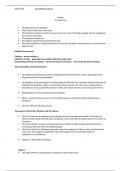Lecture notes
Constitutional Law Lecture: The executive (notes)
- Module
- Constitutional law
- Institution
- Manchester Metropolitan University (MMU)
in the lecture notes it includes: Political government the composition of the government the powers of the prime minister and the history History of the office of prime minster residence The cabinet/ functions Royal prorogrative
[Show more]




